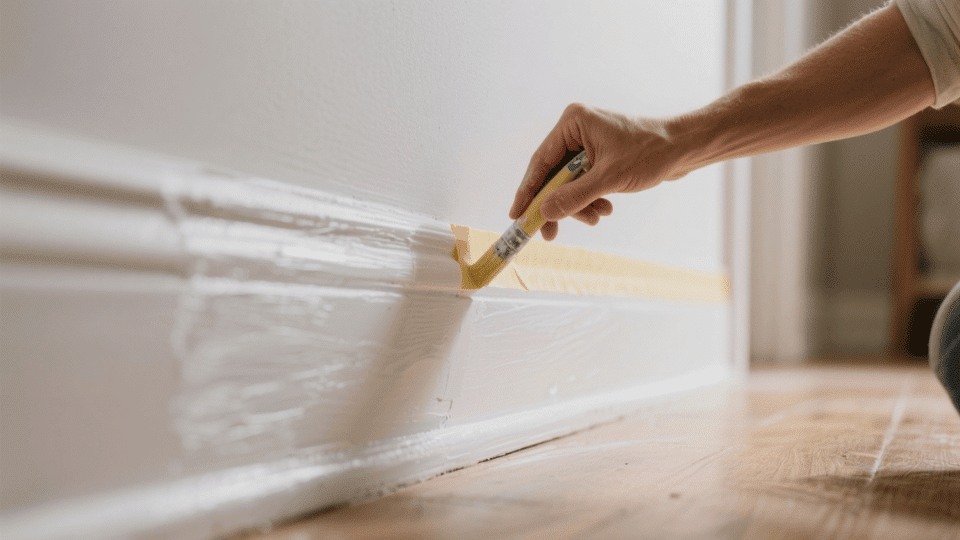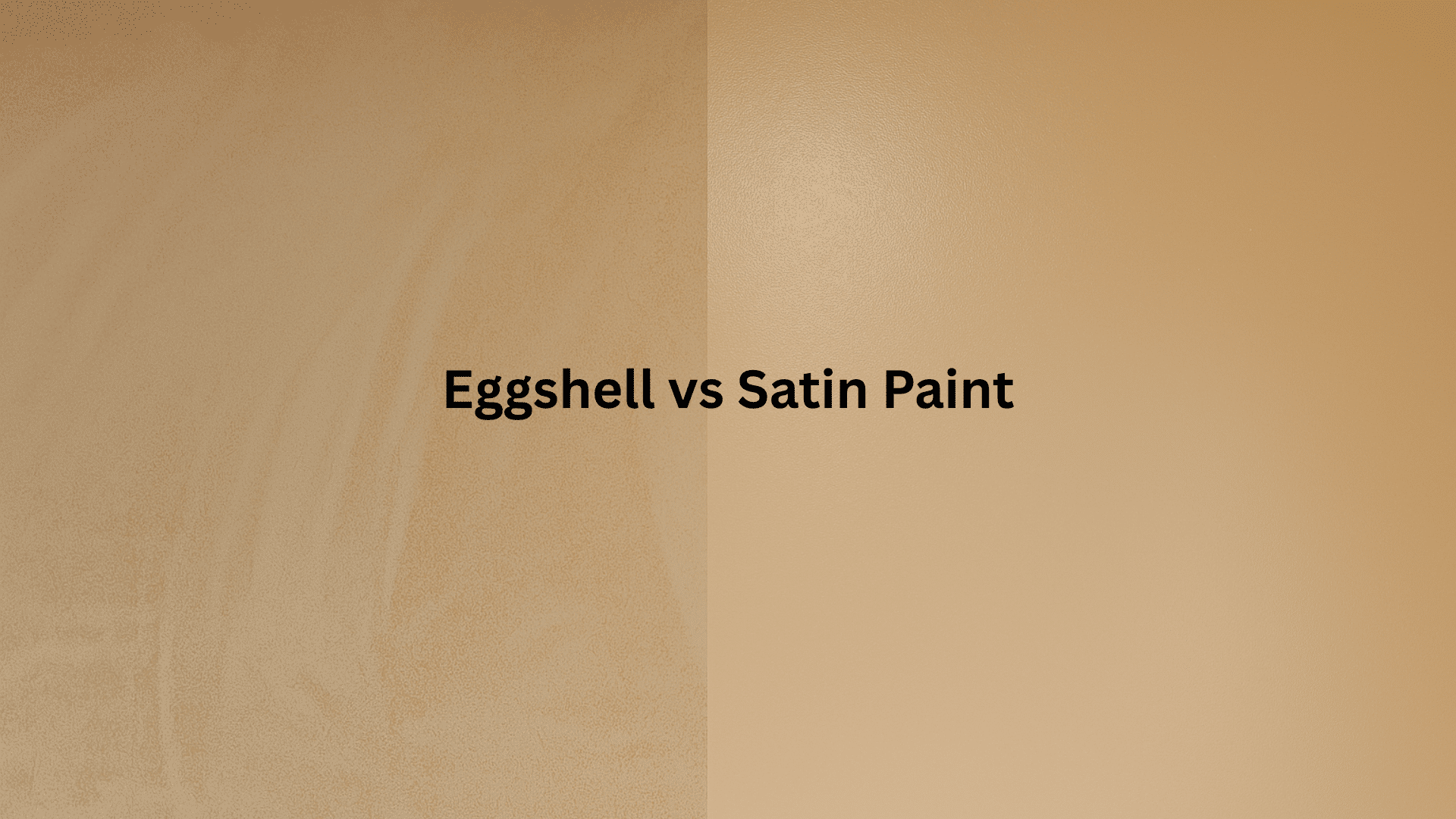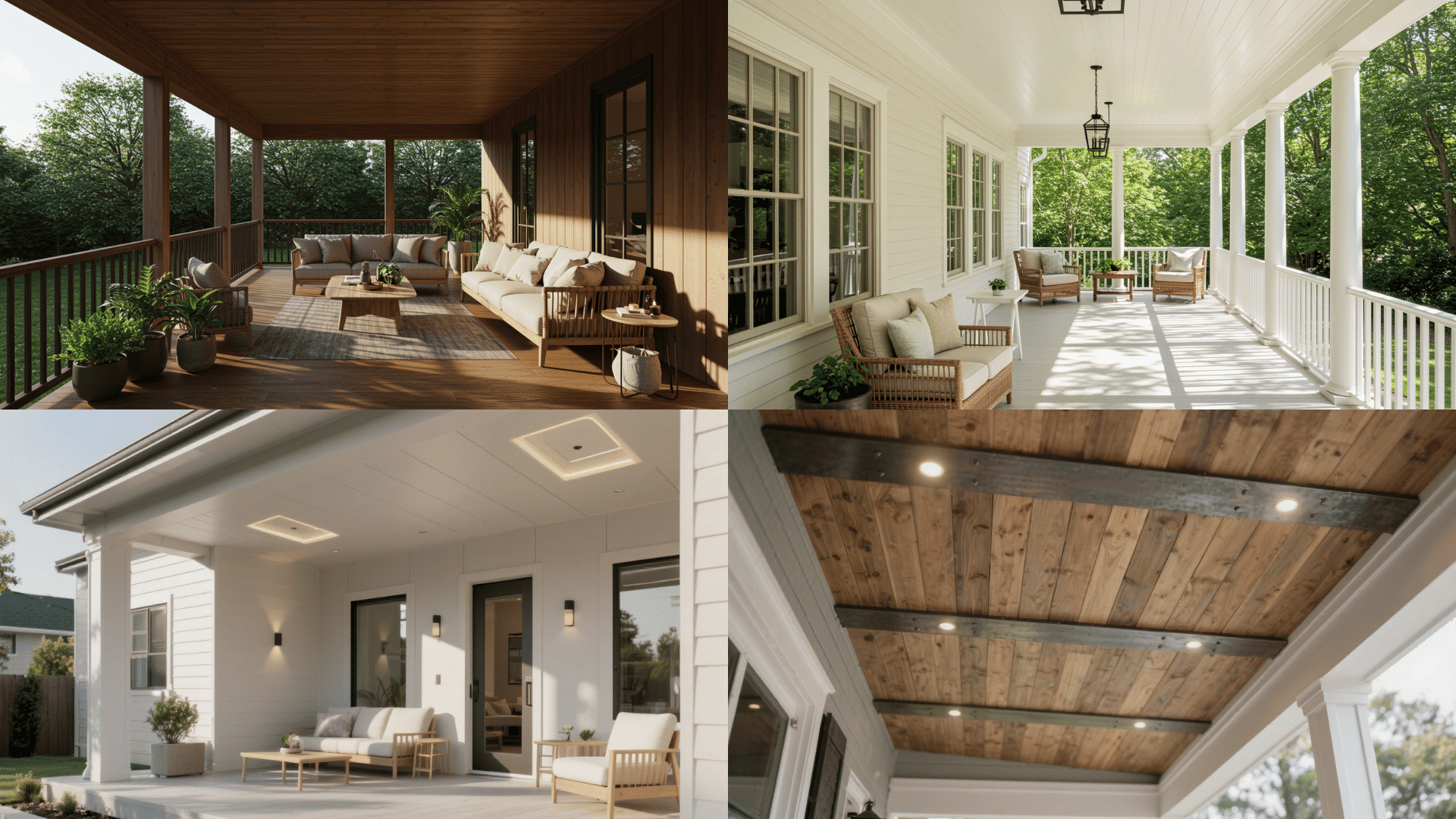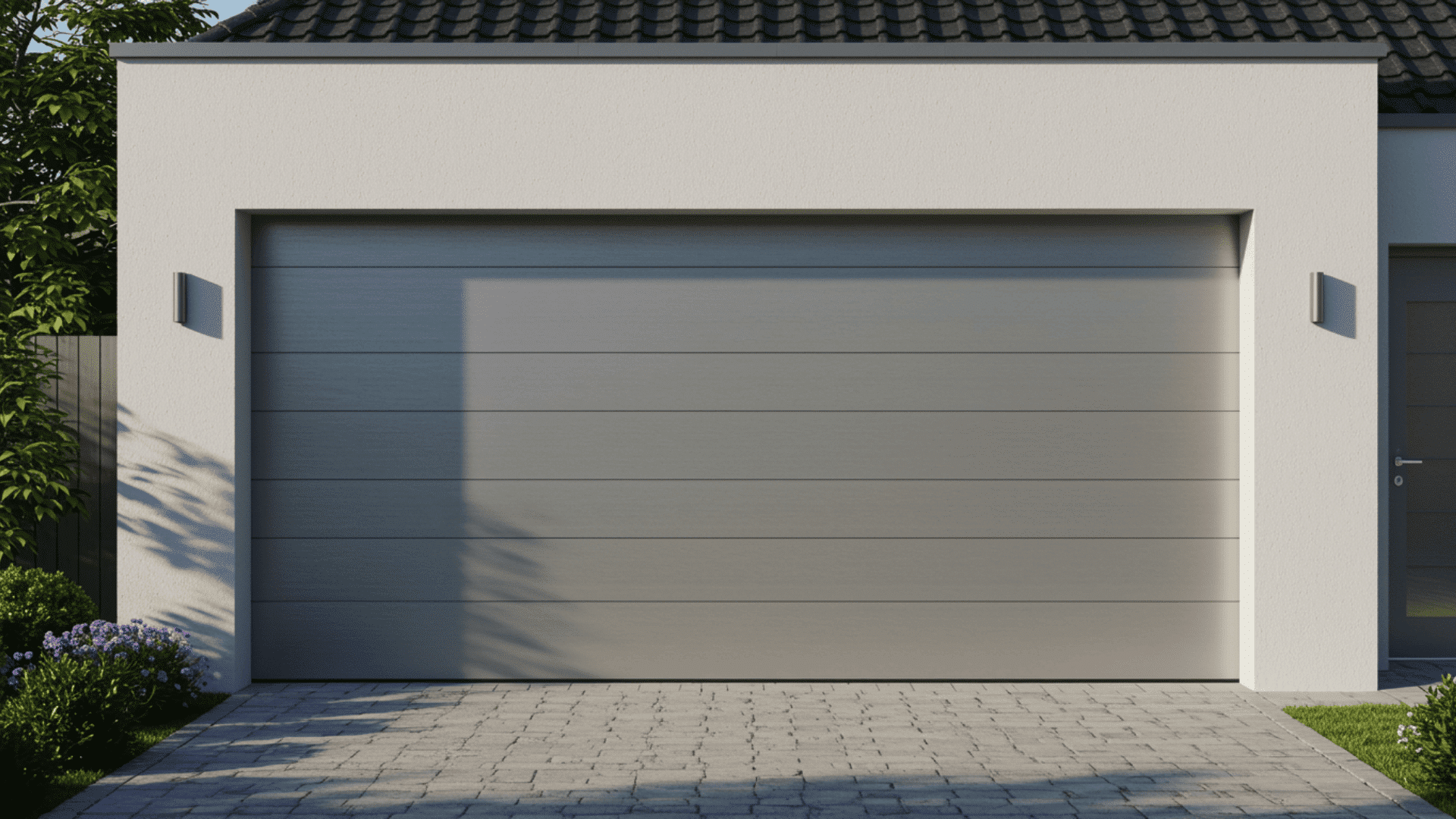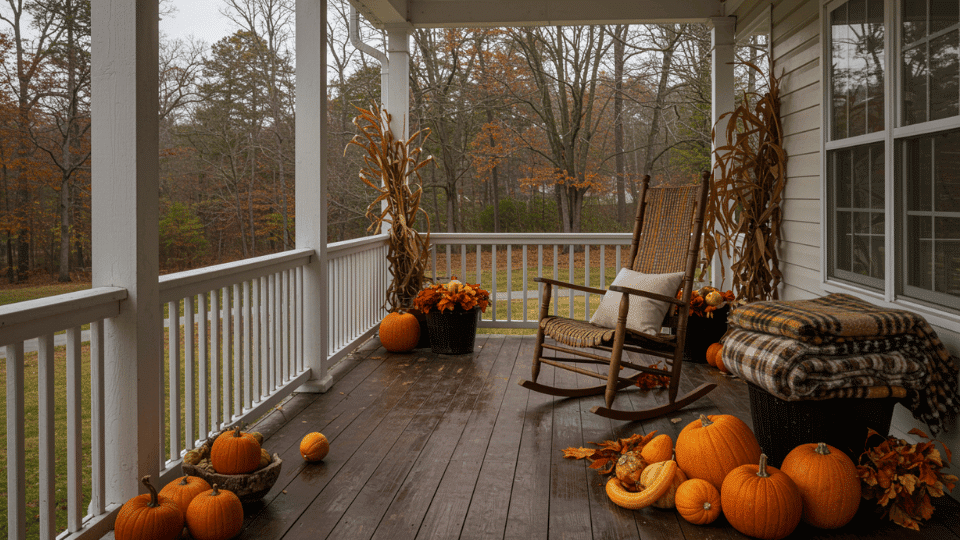I used to overlook baseboards completely, those thin strips of trim that seem to blend into the background. But once I realized how much they influence the overall feel of a bathroom, everything changed.
Clashing or fading baseboards disrupt a space’s balance. Painting them reveals a key design trick many homeowners overlook.
Combined with smart bathroom color choices and popular hues that open up smaller spaces, this simple detail becomes a secret weapon for making any room feel brighter, larger, and more polished.
What Painted Baseboards Do for Your Room?
Painted baseboards serve as the visual anchor between your walls and floors, creating a finished transition that signals attention to detail.
When they’re dingy, chipped, or painted the wrong shade, they draw the eye for all the wrong reasons, making your entire bathroom feel neglected, even when it’s actually clean.
In compact bathrooms, knowing how to paint baseboards properly works magic on perceived space. Fresh white trim creates sharp lines that define boundaries, making walls appear taller and rooms feel less cramped.
Bathroom color ideas that leverage the interplay between wall and trim to maximize visual square footage.
Tools and Materials Needed to Paint Baseboards
Having the right supplies organized before you start prevents frustrating mid-project trips to the hardware store and ensures professional results.
| CATEGORY | ITEMS | PURPOSE |
|---|---|---|
| Application | 2-inch angled brush, foam brush | Precision cutting and smooth coverage |
| Prep Work | 120-grit sandpaper, tack cloth | Surface smoothing and dust removal |
| Protection | Painter’s tape (1.5-inch), canvas drop cloths | Clean lines and floor protection |
| Coating | Stain-blocking primer, paint (satin/semi-gloss) | Adhesion and durable finish |
| Cleaning | TSP cleaner, microfiber rags | Grease and grime removal |
Step-by-Step on How to Paint Baseboards
Follow these steps to achieve crisp, professional-looking baseboards that stand up to bathroom humidity and daily wear.
Step 1: Prepare the Area
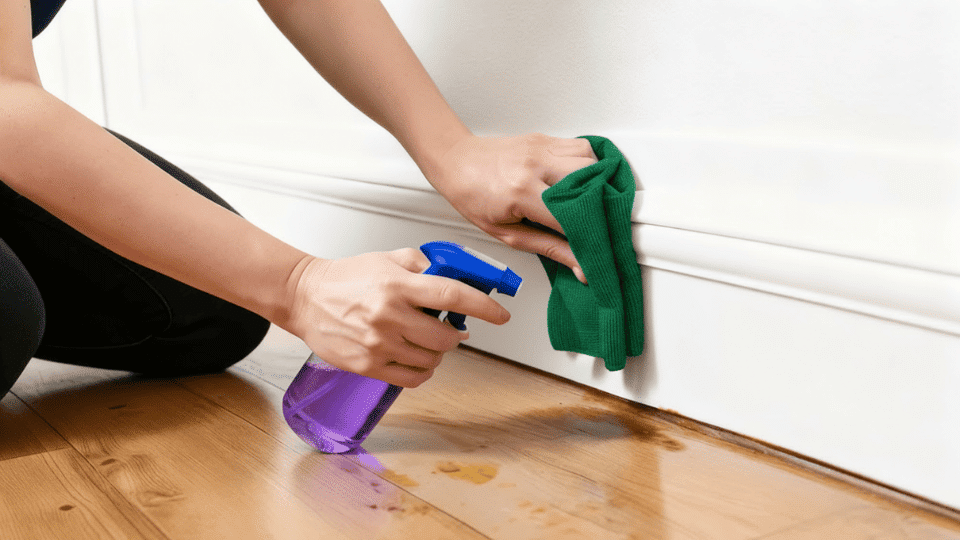
Clean baseboards with TSP or a degreasing solution to remove soap scum, dust, and oils, then let them dry completely before painting.
Apply painter’s tape 1/16 inch above the baseboard along the wall edge, pressing firmly to seal. Lay drop cloths against the baseboard to catch drips.
Step 2: Sand and Prime

Sand baseboards with 120-grit sandpaper using light, even pressure to smooth rough patches and improve paint adhesion, then wipe away dust with a tack cloth.
Apply a thin coat of stain-blocking primer with an angled brush, working in the direction of the wood grain. The primer seals old stains, prevents bleed-through, and creates a uniform base for true topcoat color.
Step 3: Paint with Precision

Load your angled brush with paint, tapping off excess, then use long, smooth strokes along the baseboard while keeping a wet edge to avoid lap marks.
Cut carefully along the top edge where the baseboard meets the wall, using the angled bristles as a guide. Apply two thin coats for faster drying and a smooth, drip-free finish.
Step 4: Finishing Touches

Allow the final coat to dry for at least four hours before removing tape. Pulling too soon risks smearing wet edges. Peel tape at a 45-degree angle, working slowly to prevent paint from lifting.
Inspect the baseboards in natural light, looking for thin spots, missed corners, or uneven coverage. Touch up imperfections with a small brush, feathering edges into the dried paint so repairs blend invisibly.
Bathroom Color Ideas That Pair Well with Baseboards
Once you understand how to paint baseboards with the right finish, selecting wall colors that complement your trim becomes the next crucial design decision.
1. Bright and Airy Whites

White-on-white bathrooms never go out of style because they maximize light reflection and create the illusion of expanded square footage.
In small bathrooms, especially, this monochromatic approach makes walls recede and ceilings feel higher. The key lies in choosing whites with subtle undertones that prevent the space from feeling sterile or cold.
Recommended color:
- Sherwin-Williams Pure White (SW 7005): Crisp, clean white with cool undertones that brightens without feeling stark.
- Benjamin Moore White Dove (OC-17): Soft, warm white with gray undertones that prevent a sterile look.
- Sherwin-Williams Alabaster (SW 7008): Adapatable greige-white with warm undertones for a cozy yet airy feel.
2. Calm and Nature-Inspired Retreats
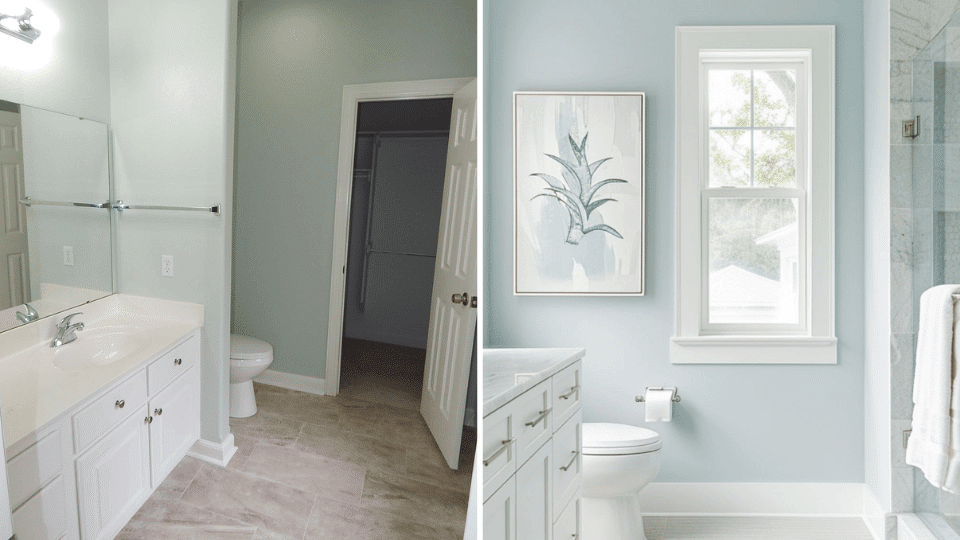
Nature-inspired bathroom colors create tranquil, spa-like atmospheres that move beyond stark white while maintaining brightness and functionality.
These soft, earthy hues paired with contrasting baseboards add architectural interest without overwhelming small spaces. The muted walls recede gently while crisp trim defines boundaries, offering visual depth that feels both calming and purposeful.
Recommended colors:
- Sherwin-Williams Sea Salt (SW 6204): Soft seafoam green with gray undertones that creates a fresh, coastal-inspired retreat without feeling too cool.
- Benjamin Moore Gray Wisp (1570): Gentle misty blue with subtle gray notes that delivers modern refinement and calming flow.
- Sherwin-Williams Accessible Beige (SW 7036): Warm taupe with balanced undertones that grounds the space while maintaining an airy, organic feel.
3. Warm Neutrals for Cozy Spaces

Warm neutral bathrooms transform functional spaces into inviting sanctuaries that wrap you in comfort from morning routines to evening wind-downs.
These earthy tones create cozy atmospheres without losing light, perfect for bathrooms without natural light or seeking a retreat. Warm neutrals add character and grace while remaining adaptable for styles from traditional to modern farmhouse.
Recommended colors:
- Sherwin-Williams Kilim Beige (SW 6106): Warm, sandy beige with subtle yellow undertones that creates instant coziness without feeling heavy or dated.
- Benjamin Moore Revere Pewter (HC-172): Balanced greige with a warm gray-beige blend that adapts beautifully to different lighting conditions throughout the day.
- Sherwin-Williams Latte (SW 6108): Creamy tan with rich brown undertones that deliver grounded warmth and pair beautifully with natural wood and brass fixtures.
Choosing How to Paint Baseboards Right?
Bathrooms require moisture- and mildew-resistant paint, especially with fungicides to prevent black spots in humid conditions. Look for ‘bathroom paint’ labels or mildew-resistant additives.
For finish compatibility, match your baseboard sheen to existing trim throughout your home. If door frames and window casings wear a semi-gloss finish, your baseboards should too.
This creates visual continuity. In bathrooms specifically, semi-gloss outperforms satin because it repels water droplets and wipes clean more easily, though satin offers a softer look if durability isn’t your top concern.
Common Mistakes to Avoid When Painting Baseboards
Even experienced DIYers make avoidable errors that compromise baseboard appearance and durability, especially in moisture-prone bathroom environments.
- Skipping the primer step: This leads to uneven color absorption, poor adhesion, and visible stains bleeding through your topcoat.
- Using flat or eggshell finishes: These absorb moisture and stains in bathrooms, making them difficult to clean without damaging the paint.
- Overloading your brush with paint: Creates drips, runs, and thick buildup in corners that look amateur and take forever to dry.
- Painting over dirty or greasy surfaces: Prevents proper adhesion, causing paint to peel within months despite quality products.
- Removing tape while paint is still tacky: Results in ragged edges and pulled-up paint that requires tedious touch-ups.
Avoiding these pitfalls ensures your baseboards maintain their fresh appearance despite years of bathroom humidity, daily cleaning, and foot traffic.
Final Thoughts
Learning to paint baseboards efficiently transforms bathrooms from overlooked spaces into polished retreats. Fresh trim and strategic wall colors add architectural definition, making small bathrooms feel bigger and more graceful.
I’ve found that proper preparation and thin, even coats make the difference between amateur results and professional-grade finish.
Ready to remodel your bathroom? Grab your angled brush, choose your paint combination, and start with thorough cleaning.
Your baseboards will reward you with years of crisp, beautiful performance.

